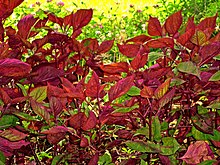Perilla oil
Perilla oil is obtained from the seeds of herbs of the genus Perilla, usually from the speciesPerilla frutescens. The seeds contain 35 to 45 percent oil which is obtained by pressing. Perilla oil is used along with synthetic resins in the production of varnishes. Perilla oil dries faster than linseed oil and on drying forms a film that is harder and yellows more than that formed by linseed oil. The paint and varnish industry accounts for the largest usage. Perilla oil also is important in the manufacture of printing inks and linoleum, and in more ancient times was a critical component in creating durable earthen floors.
In parts of Asia, perilla oil is used as an edible oil that is valued more for its medicinal benefit than its flavor. Perilla oil is a very rich source of the omega-3 fatty acid alpha-linolenic acid(ALA). About 50 to 60% of the oil consists of ALA.
In Korea, perilla is mainly cultivated in Chungcheong, Gyeongsang, and Jeolla Province, so the locals there often consume perilla oil. InKorean cuisine, it is used for marinating namul (seasoned vegetable dish), coating grilled gim (Korean laver), or pan-frying jeon(pancake-like dish),[1] where it is called deul gireum (들기름) or beopyu (법유, 法油) in Korean.[2] In North Korea, it is called deulkkae gireum (들깨기름).[3]photo
'연구하는 인생 > Natural Therapy' 카테고리의 다른 글
| Best & Worst Foods for Gallbladder Disease (0) | 2014.04.06 |
|---|---|
| Three Foods That Get Rid of Kidney Stones (0) | 2014.04.04 |
| Olive Oil (0) | 2014.04.04 |
| Grape seed oil (0) | 2014.04.04 |
| What is cholesterol? What causes high cholesterol? (0) | 2014.04.03 |
